Salina Cruz, Oaxaca 作者: 来源: 发布时间:2021-11-16
1.Population and Area
Pop: 89,211
Area: 113.55 km2 (munip.)
Elev: 22 masl
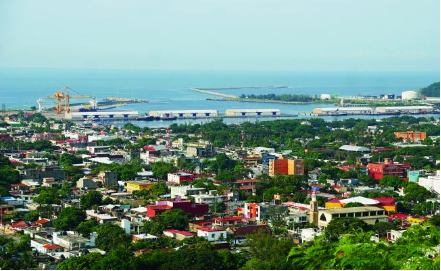
Salina Cruz location in Mexico within the state of Oaxaca
https://goo.gl/maps/PrXQCZP11kxwMtTE9
2. Natural geography
Nature and weather
Orography
Salina Cruz lacks the presence of great elevations, although the existence of hills in its periphery is considerable. The city is located in the Pacific of Juchitan and therefore, it is surrounded by beaches. The port has an altitude of 40 meters above sea level. In terms of population, Salina Cruz is the third most populous state city. It has a warm climate with moderate and intense winds with rains in summer, autumn and winter.
To the west of Salina Cruz are located on the top of a hill, two stones of approximately 1000 meters in height which are called Piedra Cuache or Piedra Cuachi, the stone is the product of the erosion that the hills of the city have suffered , the height of the stone allows to see it from several meters away, although it is not a tourist object, it is only part of the geography of the city.
Hidrography
The sources of water available to the municipality come from the Rio de Tehuantepec. It is located in the Gulf of Tehuantepec, made up of beautiful beaches and recognized for its beautiful port, which is of great importance for the commercial activity it develops.
Flora and fauna
The vegetation formed by: nopal, mesquite, quelite, pumpkin flower and coconut.
The fauna is made up of coyote, fox, opossum, skunk, armadillo, lion, wild boar, bobcat and panther, among others.
Köppen Classification: Tropical Savanna Climate
Tropical savanna climates have monthly mean temperature above 18°C (64°F) in every month of the year and typically a pronounced dry season, with the driest month having precipitation less than 60mm (2.36 in) of precipitation. In essence, a tropical savanna climate tends to either see less rainfall than a tropical monsoon climate or have more pronounced dry seasons than a tropical monsoon climate. Tropical savanna climates are most commonly found in Africa, Asia and South America. The climate is also prevalent in sections of Central America, northern Australia and North America, specifically in sections of Mexico and the state of Florida in the United States.
The Köppen Climate Classification subtype for this climate is "Aw". (Tropical Savanna Climate).
The average temperature for the year in Salina Cruz is 81.0°F (27.2°C). The warmest month, on average, is May with an average temperature of 84.0°F (28.9°C). The coolest month on average is January, with an average temperature of 78.0°F (25.6°C).
The highest recorded temperature in Salina Cruz is 98.0°F (36.7°C), which was recorded in May. The lowest recorded temperature in Salina Cruz is 62.0°F (16.7°C), which was recorded in January.
The average amount of precipitation for the year in Salina Cruz is 38.5" (977.9 mm). The month with the most precipitation on average is June with 11.6" (294.6 mm) of precipitation. The month with the least precipitation on average is January with an average of 0.0" (0 mm). In terms of liquid precipitation, there are an average of 70.3 days of rain, with the most rain occurring in June with 15.8 days of rain, and the least rain occurring in February with 1.4 days of rain.
https://www.weatherbase.com/weather/weather-summary.php3?s=33867&cityname=Salina+Cruz%2C+Oaxaca%2C+Mexico&units=
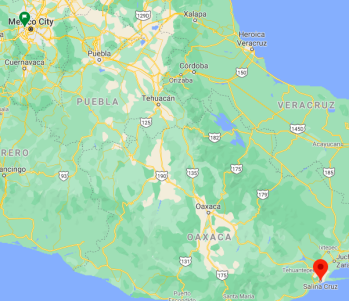
Getting there and around
Get there
By air – You can fly to Huatulco and take a bus to Salina Cruz from the Huatulco terminal. It takes approximately 4h 51m to get from Mexico City to Salina Cruz, including transfers.
By car – The distance between Mexico City and Salina Cruz is 552 km. The road distance is 724.1 km.
By bus – The cheapest way to get from Mexico City to Salina Cruz is to bus via Oasis which costs $620 - $640 and takes 9h 21m. There is a direct bus departing from México TAPO and arriving at Salina Cruz. Services depart every three hours and operate every day.
Car Rental – To explore Mexico’s provincial towns and cities—including its beach locations and the scenery and attractions near them— consider renting a car for your visit. Having your own car will give you more flexibility than using public transport options and, in some cases, offer you access to places which are otherwise difficult to visit without the use of a car.
COVID19 – International entry into Mexico from United States
Allowed for: All visitors arriving by air. Mexico land borders are closed to non-essential travel
Restricted for: There are no current restrictions.
Get around
Local Buses – Local buses and mini-buses (combis or micros) are available locally for a fraction of the cost of a taxi around town. You need to speak Spanish to be able to ask for directions or ask the driver to tell you where to get off.
Taxis – Taxis in most of Mexico’s towns and cities are not metered, so agree your price before you get in. Taxi travel is very affordable in Mexico, in comparison to the USA, Canada and Europe, and so provides a viable means of public transportation in Mexico. Your hotel can arrange taxis for you; some post their rates on a board in the lobby; taxi hotel rates are usually higher than cabs you hail off the street. If you speak Spanish, you will have a distinct advantage and be able to negotiate a price with the driver.
Uber is expanding rapidly across Mexico and now offers services in cities across the country, including: Mexico City, Toluca, Cuernavaca, Puebla, Querétaro, León, Aguascalientes, San Luis Potosí, Guadalajara, Monterrey, Hermosillo, Tijuana, Mexicali, and Mérida. Uber has been adding Mexican cities to its network every year, check for availability when you arrive at your destination in Mexico.
Cabify and Didi are also developing and currently operate in cities including Mexico City, Toluca, Monterrey, Puebla, Querétaro and Tijuana. Check for availability in the city you are visiting.
These services offer people with smartphones a way to book a cab through a mobile app for a pre-agreed price. Fares are comparable with Sitio type cabs, and sometimes trade at a premium to this when local demand increases.
https://www.mexperience.com/transport/taxi-travel-in-mexico/#51
3. ECONOMY
GDP: 18,692 M MXN (2010, Tehuantepec-Salina Cruz metro area)
https://imco.org.mx/ciudades2010/ciudades/32_Tehuantepec.html
4. Industry characteristics
Salina Cruz was a fishing port, which began by giving shelter to different vessels belonging to various cooperatives, who offered work to most of its inhabitants.
At present it is an important industrial center of the state of Oaxaca, due to the presence of the Ing. Antonio Dovalí Jaime Refinery of Petróleos Mexicanos, which provides work to a part of the population, benefiting the economy directly and indirectly of the city. It is also considered a high-altitude port and one of the most important on the Mexican Pacific coast, in addition to the commercial activities that are carried out.
Shipyard number 10 of the Secretariat of the Navy and the Twelfth Military Naval Zone are also sources of employment. It has the Shipyard, the largest dry dock in Latin America, an afloat repair dock and a synchro-lift powered by 28 electro-synchronous motors for repair and shipbuilding.
The "Integral Port Administration", a Mexican company, offers its services of: berthing, port maneuvers, docking, equipment rental, storage service, weighing service, port service, consolidation / deconsolidation and use of consoles for refrigerated containers.
By rail it is communicated with Coatzacoalcos and intermediate points and by air to the Federal District, Oaxaca and Huatulco.
In the city there is also the Naval Air Station of Salina Cruz in which only military operations are carried out.
Salina Cruz has become the second city with the highest economic growth in the State of Oaxaca, although although with a level of commerce far behind the Oaxacan capital, it currently has an accelerated growth rate.
In addition, the city has already established supermarkets and shopping malls that house many national and transnational companies, not counting others that are under construction or planning, thus activating the activity of the city and making it flow.
Main economic activities of the municipality
Primary sector: agriculture, livestock, forestry and fishing
Secondary sector (industry): manufacturing, building, electricity and water
Tertiary sector (services): commerce, transport and comunication, tourism, public administration.
https://www.ecured.cu/Salina_Cruz_(M%C3%A9xico)
Key project: Salina Cruz as part of the Interoceanic development project
As part of the Federal Government mega project of connecting the two oceanic areas through a modern train infrastructure, and developing one of the most underdeveloped regions of Mexico, the port of Salina Cruz is considered as one of the key areas that will take advantage of the commercial advantages that this project will deliver to the entire Southeast region of Mexico.
Among the infrastructure works considered by the project, is the modernization of the port of Salina Cruz, and strengthening the highway and rural road infrastructure, as well as the construction of a gas pipeline, which is already being tendered, to supply companies and consumers of area. In addition, a fiber optic line will be laid along the Isthmus to strengthen digital connectivity in the region for the benefit of companies and communities that currently lack internet service, so they will be able to connect in public spaces.
The program is focused on benefiting the most vulnerable population in the region, in order to meet the mandate that it be the least favored groups that in the future reap the benefits of progress. In addition, he stressed, government programs will be targeted to meet the needs of families, people of working age, and the elderly, and the creation of opportunities for young people and school-age children will be promoted.
https://www.gob.mx/ciit/articulos/presentacion-del-programa-para-el-desarrollo-del-istmo-de-tehuantepec-227166?idiom=es
5. Attractions
Playa Azul
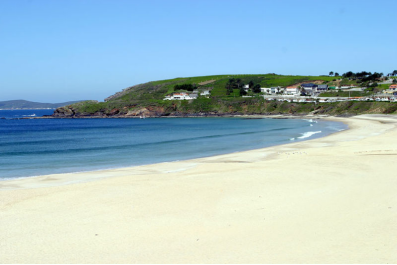
Located about 15 minutes from Salina Cruz, Playa Azul is a beach of considerable size, which appears as a vast bay. It has a moderate slope and very fine-grained sand. The water has blue tones, it is quite warm and has a moderate swell. The place is very peaceful and therefore many inhabitants of the nearby communities tend to visit it on weekends and holidays. Playa Azul has a hammock rental service and a restaurant.
At the end of the sanitary crisis and with the pertinent measures, Playa Azul is a good option to enjoy Salina Cruz, which is located a few minutes away and in it you can enjoy its warm waters of blue tones, its moderate swell and its cool breeze.
Because it is a peaceful and relaxing place, it is the favorite of the inhabitants close to this place.
https://maritzascarlett.com/playa-azul-en-salina-cruz-oaxaca
Bahía La Ventosa
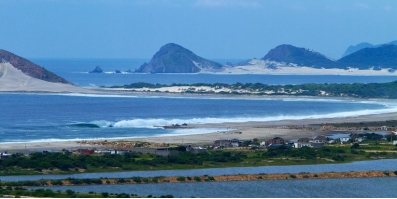
Located about 10 minutes from Salina Cruz, La Ventosa is a perfect beach to enjoy on vacation. As in the case of Playa Azul, it has a moderate slope and medium-grained sand. The waters are very pure blue and have a medium intensity swell. On the beach there are several restaurants where delicious regional snacks are prepared, several of them prepared with seafood. Fishermen in the area offer motorboat tours around the bay, to see other beautiful beaches in the area.
Las Escolleras
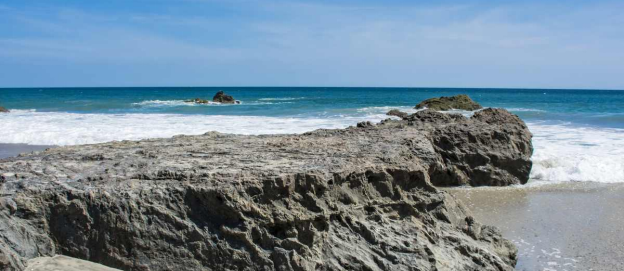
With memorable landscapes, Las Escolleras stands out because in the depth of the water some hills are born in the distance. Also shaped like a bay, this coastal area has moderate waves of an intense blue color. Throw yourself in the sand and enjoy the relaxing sensation of feeling your feet relax.
It has a moderate slope with medium-grained sand. The water is warm; There is restaurant service and boat rental. It is also possible to find a recreational center with swimming pools, slides, food and social areas owned by Pemex and accessible to the general public.
https://www.cityexpress.com/blog/playas-salina-cruz-oaxaca
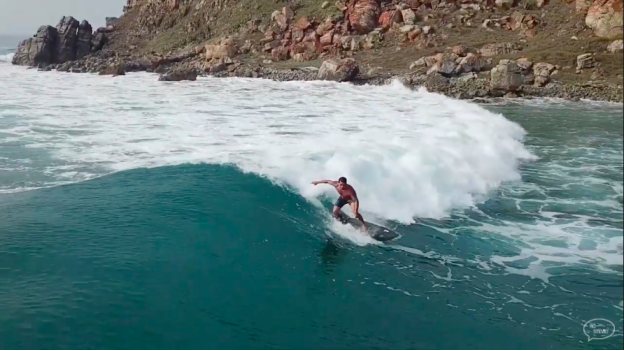
EMPTY SALINA CRUZ SURFING
https://youtu.be/kLQYcK7x4P0
6. History
The origin of the name of this port is lost between history and legend. Legend has it that the first settlers who arrived on this coast were men and women from Tehuantepec, of Huaves, Chontales, Zoques origin, who in turn were displaced by Zapotecs and Mixtecs; that were established in different times and places. These civilizations had a marked influence of the Olmec culture, who were as nomadic explorers to expand their power, strength and cultural development, and, attracted by the exploitation of the Colorada Ike-sidi-bia lagoon that provided them with fish and other products. Marine when it was full, and salt when the water of the lagoon was exhausted, they settled in this place. Later, with the Hispanic conquests, Catholic missionaries arrived to evangelize the population, being rejected by the locals, these, before the rejection of the settlers, tried to win their affection through faith, and therefore one night they plotted to form in the middle of the lagoon curdled in salt a cross which when the natives saw it constituted a miracle that made them accept the Catholic faith, this being the reason for the name salt and unified cross in Salina Cruz.
The Zapotecs came to form and preserve their empire for a long time, in Güiengola, until the arrival of white and bearded men, led by the intrepid and voracious conqueror, Hernán Cortés. History says that in 1527, Hernán Cortés reached the shores of the Isthmus of Tehuantepec and since then, upon discovering the bay of La Ventosa, he foresaw a maritime route, founding in this place a shipyard and a lighthouse, on top of Cerro El Morro (1528), fed with turtle oil given the good geographical conditions that Mother Nature offered them. That was where the boats that helped him to discover and conquer the lands of the coasts of Baja California, today the Gulf of Cortés, were built and as a reminder of these feats, the Cortés lighthouse still exists in the port of Salina Cruz. In May 1527 Cortés sent the King of Spain a letter of relationship informing him that he had prepared three ships that, under the command of Álvaro de Saavedra Cerón, left the shores of Tehuantepec to conquer the Moluccas.
In 1529 another ship built in the bay of La Ventosa under the command of Diego de Ocampo, traveled to Callao, Peru, later establishing itself on a Mexico-Peru route.
In 1532, by indications of Cortés, two ships were prepared, captained by Hernando de Grijalva and Diego Becerra with the mission of discovering new lands on the coasts of the South Sea. In 1533 three ships were armed (San Tomas, Santa Águeda and San Lázaro) on the coast of Tehuantepec, departing on orders from Cortés to the port of Chinameta. In 1534, Hernando de Grijalva's expedition to California departed from Tehuantepec (see Grijalva's Expedition to the Equatorial Pacific).
It is known by other historians that on June 6, 1528, Hernán Cortes received the title of "Marqués del Valle", the King of Spain giving him the lands conquered from Cuernavaca to the isthmus of Tehuantepec, whose area included the port that was installed in which is now La Ventosa, an event known as “Puerto Cortés”.
In 1531 the conqueror was deprived of this right because the conqueror came into conflict with the Antequera town hall when defending Francisco de Paz, whom he appointed Mayor Mayor and about whom the Town Hall complained about abuses of authority in his town hall.
Cortés objected before the Council of the Indies the determination of the Royal Academy, entering into the litigation that lasted 29 years; In 1560 the ruling was in favor of Cortés and as he had already died, the King of Spain, Felipe II, recognized as heir to Don Martín Cortés, son of the conqueror, of all the rights over the towns, places and villages that were awarded to your father.
In this ruling, the Royal Certificate said that Tehuantepec with its objects, which is a port in the South Sea, was kept for the Royal Crown, so the Vice-Royal Government took possession of the Port due to its importance for trade through the South Sea and conquests in Asia and Oceania.
Already being part of independent Mexico, the port of Salina Cruz arises as a result of the investigations carried out to build a ceramic metro plant on the Isthmus of Tehuantepec, through which it was concluded that the Santa Cruz pier was the Best place to build an artificial port by means of a Presidential Decree, the government offices that had their seat in La Ventosa were ordered to move to Salina Cruz and the then president Don Benito Juárez García on May 10, 1871 legally declared it as Puerto de Altura. Since then, a lavish date has been celebrated, according to custom, with 3 holidays 10, 11, and 12 May.
The following year, on February 5, 1872, Salina Cruz was born as a port, which was a village, a congregation of humble fishermen, by order of the superior government, who officially committed to promoting the commercial and economic development of the entity, begins its dawn. Event of great significance. The illustrious Mexican, champion of liberal thought, Lic. Don Benito Pablo Juárez García, directed the destinies of the homeland.
At the end of the 19th century and at the dawn of the 20th century, Salina Cruz grew rapidly, due to the Tehuantepec - Coatzacoalcos railway, workers from other latitudes of the world, the trans-isthmian railways were unable to provide for the transport of passengers and materials, since the English company Pearson plans, builds the port and the city, from 1894; commerce is notorious, the population rises to 738 inhabitants (December 1, 1900), influencing the members of the workers' camp.
In the government of Porfirio Díaz, the Battle of Salina Cruz occurred between Mexicans and Americans. The Americans were looking to build a canal similar to the one in Panama in the Tehuantepec-Coatzacoalcos area. The filibusters were organizing a large armed group, with which they would declare the independence of the purchased territories and then sell them to the United States for a much higher price. The Americans had done the same thing in West Florida with the Spanish and in Texas with the Mexicans, claiming that "the people were the ones who asked to be American." 8 In the short-lived battle, the Mexican guns defeated the small American fleet, deciding abandon the idea of conquering the isthmus.
On January 20, 1901, Salina Cruz ceased to be a municipal agency to become a free municipality, having the high honor and great historical commitment of being the first municipal president of the port, Dr. Roberto Medina Jiménez. Likewise, the civil registry begins to control the births and deaths of this nascent city, with relevant progress to unite the Atlantic Ocean with the Pacific, through the port of Mexico, Veracruz, and the port of Salina Cruz Oaxaca.
The port of Salina Cruz was considered a free municipality since January 20, 1901. In the port of Salina Cruz, 35% of the inhabitants are natives, and 65% of the population originate from different parts of the Republic and other latitudes of the world. Its boundaries are, to the north, with the municipalities of Santo Domingo Tehuantepec and San Blas Atempa: to the south with the Gulf of Tehuantepec, to the east; with the municipalities of San Mateo del Mar, San Pedro Huilotepec and the Gulf of Tehuantepec and to the west with the municipality of Santo Domingo Tehuantepec.
Modern history begins at the end of the 1970s with the construction and start-up of the Refinery "Ing. Antonio Dovalí Jaime" of Petróleos Mexicanos, where up to 330 thousand barrels per day of crude oil extracted in the country are refined and it exports to the whole world through oil tankers that arrive and are supplied in buoys located in the high seas; This is why the port has become one of the most important nationally and is recognized worldwide.
At the beginning of 2012, large investments arrived at the port that raised the spirits of the citizens, with a great rebound in the economic and social aspect, with these investments the construction of one of the most important department stores in the country, Liverpool, and also from super malls like Sam's Club and Walmart. At the end of 2012 the first commercial plaza in the city called Pabellón Salina Cruz was inaugurated. Also to this plaza is added the project of "Galería Metropolitana del Istmo" made up of Soriana, Cinepolis and Home Depot; "Galleries Istmo" formed by Liverpool that currently operates in the port. The city, today, is considered one of the most important in the south for its oil and fishing industry, and soon commercial and social.
On June 14 and 15, 2017, there was an explosion at the Antonio Dovalí Jaime Refinery caused by the accumulation of gases in one of the pipelines, which caused the fire that had been registered the previous day due to an ignition of fuel and fuel to reignite. Oil accumulated from the flooding that was reported last Tuesday after Storm Calvin.
7. Other Information: 2017 Oaxaca earthquake and reconstruction
On September 7, 2017, the 2017 Chiapas Earthquake shook the city along with other surrounding towns such as Santo Domingo Tehuantepec, Juchitán de Zaragoza and other cities in the region; Consequently, an explosion derived from the earthquake occurred at the "Antonio Dovalí Jaime" refinery, however, the state Civil Protection instance reported that there was no serious damage derived from the explosion. Old and important buildings such as the Municipal Palace, the Federal Palace, the Main Market "Ignacio Zaragoza", among others, were greatly affected, the latter ending with its inevitable demolition.
One year after the earthquake of September 7, 2017, which devastated a large part of the public infrastructure in the Isthmus of Tehuantepec, Oaxaca, the GIA Foundation of Hipólito Gerard Rivero and allied organizations delivered to the municipality of Salina Cruz, the new market "Ignacio Zaragoza ", whose rehabilitation cost around 35 million pesos.
The reconstruction of this work seeks to benefit more than 2,000 people directly and the entire population of the Isthmus, since it is one of the most important supply centers in the municipality and its surroundings, the foundation said in a statement.
Present at the reopening event were Alejandro Murat, governor of Oaxaca and Juan Pablo Castañón, president of the Technical Committee of the Fuerza México Trust, as well as the CEO of Pemex, Carlos Treviño and the Municipal President of Salina Cruz
8.Contact Information

City Mayor: Juan Carlos Atecas
Govt. Office Address: Calle Acapulco S/N, Centro, 70600 Salina Cruz, Oax.
Facebook: https://www.facebook.com/juancarlos.atecas
Twitter: https://twitter.com/JuanCarlosAteks
Website: https://www.salinacruz.org
